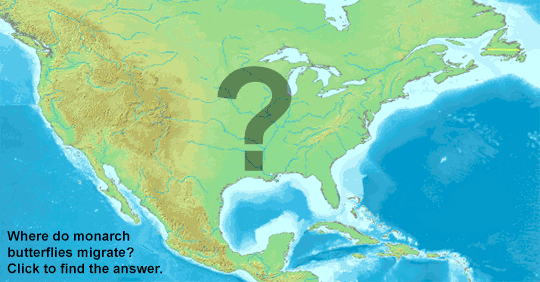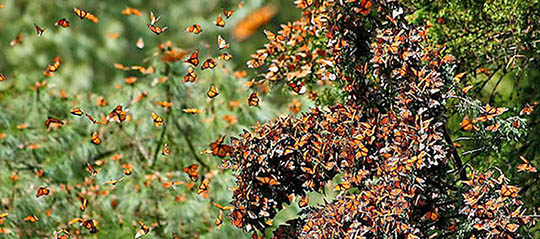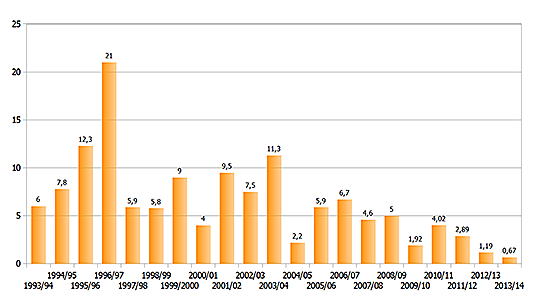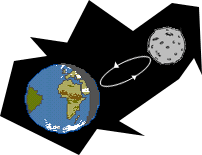How Far Do Monarch Butterflies Travel?
Imagine you are a tiny monarch butterfly. How far do you think you will travel as you migrate from your winter home to your summer home? Keep in mind that an average stick of gum weighs four times as much as your new monarch body. As you think about this, also ask yourself where your summer home is and if you have just only one.
Once you spend a minute or two thinking about life as a butterfly, click on the map below to see where you might travel.
Animated Monarch Migration Map

What's the Story Behind the Monarch Butterfly Migration?
If you looked closely at the animation, you will see there are different paths that the monarch butterflies take to and from their winter homes. Many butterflies on the west side of the Rocky Mountains travel to the north central coast of California, about 500 kilometers (~300 miles).
Many monarchs from the eastern population travel all the way to the Sierra Madre mountains in central Mexico. A monarch born in Canada would have the farthest journey of all, nearly 4,000 kilometers (2,500 miles). We now know that not all butterflies use these strict migration routes and we are hoping to learn more about why certain butterflies have specific routes.
As the butterflies fly north for the summer they produce several generations. However, the monarch in Canada returning to Mexico has to do this on its own. Think how far the tiny butterfly has to travel. In comparison, a 150 pound person would have to travel more than 13,000 times around the Earth to do what the monarch does! *

Such a long migration requires lots of energy. Not only do the butterflies have to fly, they have to eat. During each day of the trip, the monarchs must visit hundreds of flowers to get enough nectar for their trip.
Not All Is Well with Their Winter Home
Over the years, the winter home in Mexico has been shrinking. This means fewer monarch butterflies are able to survive the cold months. How this will impact them is something that scientists and concerned citizens are investigating. It is clear from the graph below that size of the habitat is growing smaller each year.

* How'd you figure that?
Let's say the average butterfly weighs 500 milligrams and the distance they will fly from Canada is about 4,000 kilometers.
For every milligram of body weight, the monarch would have to fly 8 kilometers.
4,000 / 500 = 8
Now, if we take our 150-pound person (150 pounds equals ~68,000,000 milligrams) and have them travel 8 kilometers for every milligram of body weight, they would travel 544,000,000 kilometers.
68,000,000 X 8 = 544,000,000
The circumference of the Earth is around 40,030 kilometers. When you divide total travel distance by the circumference of the Earth, you get 13,590.
544,000,000 / 40,030 = 13,590

Now you give it a try -
How many trips could the same person take from Earth to the moon and back to equal what a monarch does? We will give you one hint: the average distance from the Earth to the moon is 384,403 kilometers.
Image credit: Monarch Migration Map Animation by Harald Süpfle - via Wikimedia Commons.
Read more about: Migrating Monarchs
Bibliographic details:
- Article: Monarch Migration Map
- Author(s): Dr. Biology
- Publisher: Arizona State University School of Life Sciences Ask A Biologist
- Site name: ASU - Ask A Biologist
- Date published:
- Date accessed:
- Link: https://askabiologist.asu.edu/monarch-migration
APA Style
Dr. Biology. (). Monarch Migration Map. ASU - Ask A Biologist. Retrieved from https://askabiologist.asu.edu/monarch-migration
Chicago Manual of Style
Dr. Biology. "Monarch Migration Map". ASU - Ask A Biologist. . https://askabiologist.asu.edu/monarch-migration
Dr. Biology. "Monarch Migration Map". ASU - Ask A Biologist. . ASU - Ask A Biologist, Web. https://askabiologist.asu.edu/monarch-migration
MLA 2017 Style

Monarch Butterflies are found mainly in North, Central America and part of South Americas and are listed as Near Threatened by the IUCN.
Be Part of
Ask A Biologist
By volunteering, or simply sending us feedback on the site. Scientists, teachers, writers, illustrators, and translators are all important to the program. If you are interested in helping with the website we have a Volunteers page to get the process started.

